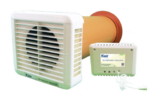I don't think you are missing anything. As you imply, there seems to be somewhat of an anomaly resulting from the fact that requirements for insulation ('to keep heat in') sit alongside requirements for rooms to have X number per hour of (heated) 'air changes'.There’s no logic though. Double glazing to save heat loss through the window. Then install a fan to extract all your heat. ... Am I missing something?
Unless/until there is heat recovery associated with those X air changes/hour, the whole thing seems essentially daft!
Kind Regards, John
Last edited:


